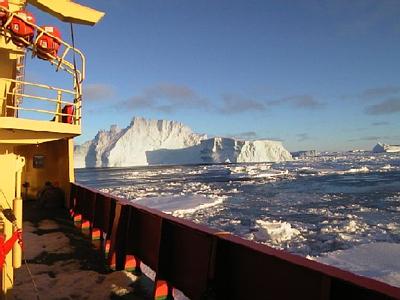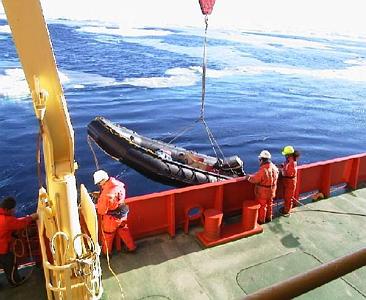24 March, 2000
Scope For the Imagination
69 02 s 90 52 w
Off Peter I Island
Temp -6 C (21 F), wind SW @ 30 knots (35 mph)
Barometer 998 mb steady
Depth 2674 m (8771 ft.)
Open water except for 9 large bergs in 360 degrees
4 m (13 ft.) seas, some tops blown off
We're in transit now, headed directly for Palmer Station on the
west side of the Antarctic Peninsula. It is about a three day trip
northeast. The Nathaniel B. Palmer can cruise at about 11.5 knots, a little
more than 13 miles per hour, so we have time to look around. I want to look
around at birds, since there are lots of them about, different and more
varied than the pack ice birds.
Even though we are in transit, we still continue to record
scientific data. Yesterday we stated to record magnetic data.
The magnetic data we gather is simply the strength of the Earth's
magnetic field in different places. Three hundred meters behind us we drag
an instrument called a magnetometer, connected by a cable to a computer
that records the information. Scientists at the Scripps Institute of
Oceanography in California have an agreement with some research vessels to
gather magnetic data whenever the ships are in transit in open water. The
data helps them unravel the history of sea floor spreading and continental
drift. Our knowledge of the ancient super-continent of Pangaea, and its
daughters/sons Laurasia and Gondwanaland, comes in part from sea floor
magnetic data.
Remember that plate tectonics tells us that ocean crust is created
at mid-ocean ridges, and that the ocean bottom spreads away on either side
of these ridges. The further you get from the ridge, the older the crust.
You may also know that the Earth's magnetic field switches polarity every
once in a while. In other words, the north magnetic pole and the south
magnetic pole switch places. (If this switch were to happen today, the
north-seeking needle of your compass would point down near where I am now.)
Ocean crust forms from lava at the mid-ocean ridges. When this lava
hardens, it "remembers" the magnetic field, reversed or normal, that was
present when it cooled. The remembered imprint is called residual
magnetism. Because the sea floor spreads from the mid-ocean ridges, this
residual magnetism shows up as symmetrical ribbons on each side. By
carefully mapping the patterns of residual magnetism on the ocean floors,
scientists can estimate positions of continents long ago, and predict where
they will be millions of years from now.
Magnetometers have been used for a long time to find submerged
submarines because the subs disturb the Earth's magnetic field. Military
sub detection specialists knew about magnetic banding of the ocean floor
before its cause was known.
The magnetometer is really a coil of many turns of fine copper wire mounted
in a bullet shaped pod full of kerosene. Kerosene is chosen because it has
a lot of hydrogen atoms. Normally the hydrogen atoms line up with the
Earth's magnetic field. Every few seconds a short pulse of direct current
is sent from the ship to the coil. When that happens the coil acts as a
magnet and lines up all the hydrogen atoms in a different direction. As
soon as the current stops, the hydrogen atoms tend to return to their old
alignment. As they do so they precess, or wobble like little tops. When
they do so, they create electricity in the coil and send a signal back to
the ship. The stronger the Earth's magnetic field, the quicker they precess
and the higher the frequency of current generated. Thus the computer can
read the strength of the magnetic field. If it is a little less than
normal, then the Nathaniel B. Palmer is probably over an area with reversed
residual magnetism, and vice-versa.
The computer automatically records the data, but we take readings
every few minutes and note them on a clipboard. I've seen some patterns in
these readings, but I'm not sure if what I am seeing is experimental error,
magnetic banding, or random noise.
Since we aren't coring or casting CTDs, we are on skeleton watches
now, only three hours per day each. This gives me time to catch up on
e-mails, do journal writing, and prepare samples and data for the end of
the voyage.
My watch is from midnight to three in the morning. Sleeping late would be
nice, but this morning I asked watch mates to wake me up at six so I
wouldn't miss our pass by Peter I Island.
I love maps, and for years I've looked at Peter I Island, wondered about it
and longed to see it. Up until a few months ago, I thought I never would
see the place. With the possible exception of Bouvet Island, it's the most
isolated open ocean island in the world. It is largely glacier covered, 18
km (11 mi.) long and 8 km (5 mi.) wide. It is about 325 km (200 mi.)
northeast of Cape Braathen on Thurston Island. The island was discovered in
1821 by the Russian explorer Thaddeus Bellingshausen, who named it for
Peter the Great. Lars Christensen Peak, the highest point on this volcanic
island, is 1755 m (5756 feet) high. Prior to the Antarctic Treaty, the
Norwegians claimed the island and maintained automated weather stations
there. The photographer Eliot Porter, in his book Antarctica, gives an
account of landing on Peter I. See if your library has a copy.
Dawn finds me standing out on the bow with several others, plunging three
meters up and down with each roller. The cup of coffee I drank when I woke
was a calculated risk; it might improve things, or it might work the other
way. Fortunately, we're headed downwind, and the bow is sheltered from the
worst of the wind by the ship's superstructure. We get lots of fresh air
but we're not too cold.
The island appears to port and ahead of us, a thin gray smudge on the gray
sea. The sun rises and quickly disappears into the clouds, but for a moment
it lights up the peak and the top of a cloud layer cutting the snowy
slopes. The island is a big white mass surrounded by rock and snow cliffs
descending into the sea. A few small black rock outcroppings break the
snowy dome higher up. Through binoculars, I can find no place to land a
boat, except for one very steep rocky beach backed up by an ice cliff. The
chart shows a slightly gentler slope on the far side; perhaps that is where
the few visitors land. More likely, they helicopter to the few relatively
flat areas.
Our visit is short. Soon Peter I Island is falling astern. Now only the
bottom third is visible, the top hidden by gray stratus clouds. The GPS
tells me there is 664 nautical miles (764 mi.) of open water to Palmer
Station. Ahead there is just sea, the line between water and sky, clouds,
and patches of blue.
I look back and the island is disappearing. Not many ships come this way.
When was it last seen and who will see it next? When was the last time
somebody stood on the peak? Will my eyes ever see it again? Peter I Island
is a desolate spot in a vast wet wilderness. What scope for the imagination!

An Amundsen Sea iceberg.

One of the two Zodiacs goes in the water.

Peter I Island at sunrise.
Contact the TEA in the field at
.
If you cannot connect through your browser, copy the
TEA's e-mail address in the "To:" line of
your favorite e-mail package.
|
